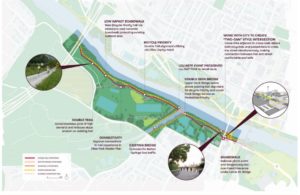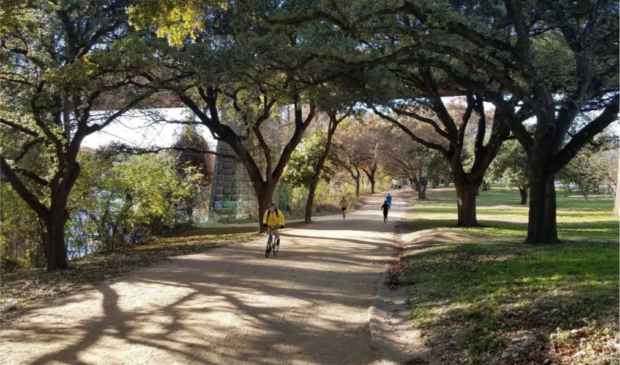Trail Foundation safety and mobility study seeks improvements
Friday, March 12, 2021 by
Sean Saldaña Stretching 10 miles, the Ann and Roy Butler Hike-and-Bike Trail is one of Austin’s most beloved features, receiving more than 4.5 million visits a year. Behind the trail’s natural beauty and serenity, however, are countless hours of planning and execution.
The Trail Foundation recently published a safety and mobility study of the Butler Hike-and-Bike Trail, developed with the city, to provide a “realistic implementable plan for conserving natural spaces while offering the highest quality user experience” to residents.
At more than 100 pages, the study gives a detailed analysis of the trail, aggregates information from community discussions and highlights the top safety and mobility concerns for the future.
Austin’s rapid rate of growth is one of the motivations behind this planning push. According to the study, the residential and employment density around the trail has doubled in the past decade and is projected to double again by 2040.
A prevailing concern among survey respondents are pinch points – areas of congestion along the trail caused by high demand, limited visibility, sharp turns, uneven surfaces, and other obstructions to traffic. The survey reports that “much of the trail will be susceptible to increasing complaints about user conflicts and pinch points due to expected growth in Austin.”
Austin Municipal Code dictates that the maximum allowable width of a hard surface trail close to a waterway is 12 feet with a 2-foot shoulder on each side, with an overall corridor area 20 feet in width. In practice, though, the actual trail width has a lot of variability. In some places, the trail can be as narrow as 8 feet across, while in others, it’s as wide as 20 feet.
To address some of the concerns around pinch points, a number of options are being considered, including trail widening, doubling the trail, slow zones, and on-street options for bikers that would help divert traffic.
The study recommends the trail be at least 14 feet wide with 2-foot shoulders on either side – with some alternative options where possible expansion space is limited like Zilker Park or Rainey Street. For these sections of the trail, the recommendation is to exercise other options like a double trail or a boardwalk. Until then, the recommendation is to pilot slow zones in those areas.
The study also recommends, however, that unless it’s currently in place, a trail should never be wider than 20 feet, plus the shoulders.
The report proposes a number of safety and mobility projects that are accompanied by a plan view and conceptual graphics.
One of the proposals includes doubling the trail from the Roberta Crenshaw Bridge (also known as the MoPac Bridge) and the Pfluger Bridge. It would also see the addition of a new, double-deck bridge that would handle pedestrian traffic on one level and cyclist traffic on the other.

The ability to execute the widespread changes needed throughout the trail is dependent on amending a part of the city’s development code.
Right now, there’s a 50-foot setback from the lake, preventing the capital and maintenance projects the Trail Foundation would like to implement.
In an interview with the Austin Monitor, Trail Foundation representatives said that while they are excited about the study and its findings, the recommendations are, ultimately, “a plan to make a plan.”
The foundation still needs to prioritize and integrate these new recommendations with the ones currently cued up.
The Austin Monitor’s work is made possible by donations from the community. Though our reporting covers donors from time to time, we are careful to keep business and editorial efforts separate while maintaining transparency. A complete list of donors is available here, and our code of ethics is explained here.
You're a community leader
And we’re honored you look to us for serious, in-depth news. You know a strong community needs local and dedicated watchdog reporting. We’re here for you and that won’t change. Now will you take the powerful next step and support our nonprofit news organization?







